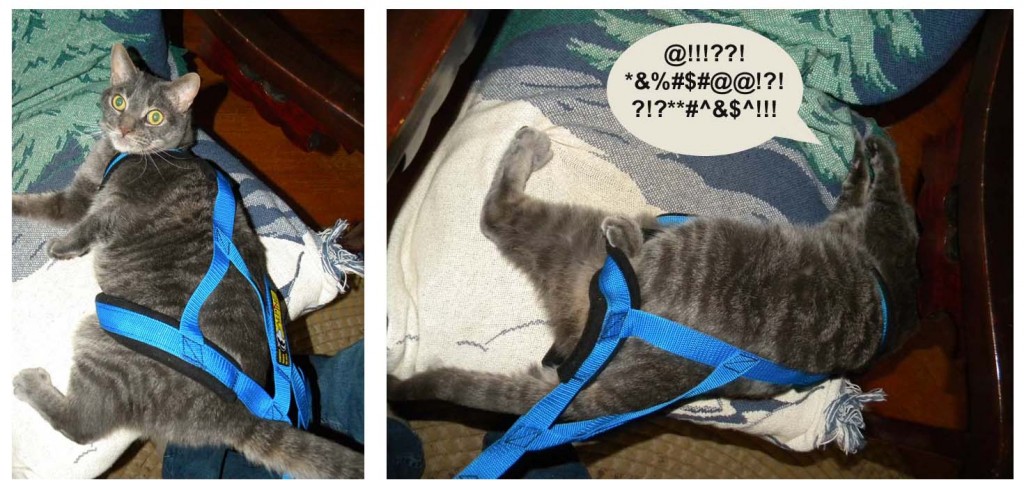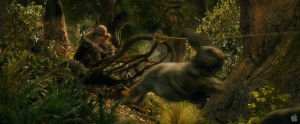 Probably one of the most controversial inclusions to The Hobbit: An Unexpected Journey was Radagast the Browns bunny sled. Fans are pretty divided over whether they love its fantastical portrayal or absolutely hate it. One of our Message Board members, swordwhale, who’s a Recreational Musher, shares her views on Radagast’s Rhosgobel Rabbits Sled.
Probably one of the most controversial inclusions to The Hobbit: An Unexpected Journey was Radagast the Browns bunny sled. Fans are pretty divided over whether they love its fantastical portrayal or absolutely hate it. One of our Message Board members, swordwhale, who’s a Recreational Musher, shares her views on Radagast’s Rhosgobel Rabbits Sled.
Radagast’s Racing Rhosgobel Rabbits:
A Recreational Musher Looks at the Realities of Bunny Sledding
A TORn Library Feature by Teanne Byerts aka swordwhale
Recreational Musher and Member of TORns Message Boards
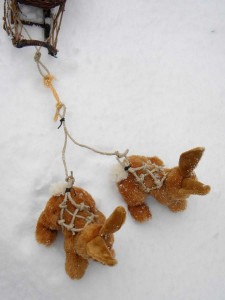 For those of us who have “lived in” Middle-earth most of our lives, the inclusion of the wizard Radagast the Brown in the film adaptation of The Hobbit was a cause for celebration. An obscure character, mentioned a few times in the books, comes to life on the Big Screen… driving a sled pulled by rabbits! Yes, rabbits! When I saw the image from the film, was I bemused? Amused? Perhaps weirded out? No way! Really? I was ROFLMAO all over my sled dog crates! To quote the Dwarf who has the Goblin King fall on his head: “You’ve got to be joking!”
For those of us who have “lived in” Middle-earth most of our lives, the inclusion of the wizard Radagast the Brown in the film adaptation of The Hobbit was a cause for celebration. An obscure character, mentioned a few times in the books, comes to life on the Big Screen… driving a sled pulled by rabbits! Yes, rabbits! When I saw the image from the film, was I bemused? Amused? Perhaps weirded out? No way! Really? I was ROFLMAO all over my sled dog crates! To quote the Dwarf who has the Goblin King fall on his head: “You’ve got to be joking!”
I have driven several kinds of things in my life (I came into the world at the same time that Lord of the Rings did): cars, trucks, tractors, lawn mowers, a hundred foot pirate ship (as guest crew, they let you drive the boat), ponies pulling carts, ponies pulling sleighs, goats pulling carts, goats pulling snow saucers, dogs pulling bikes, dogs pulling a dog rig and Siberian huskies pulling an actual sled. I am not Lance Mackey, Karen Ramstead or Aliy Zirkle, who have all run sixteen dog teams 1100 miles on the Iditarod Trail. I have four dogs and do this to amuse the dogs ( whose instinct is to run in a pack), and because I can’t run as fast as they can.
After seeing some comments from movie goers/LOTR fans who thought the bunny sled was sort of silly, or implausible, I took a closer look at Radagast’s racing Rhosgobel Rabbit ride. This is not a dissertation on CG animation (I’d need the DVD to wax eloquent about that), rather a look at the plausibility of a sled pulled by rabbits, how it works, and whether it mostly works on-screen.
Here are some thoughts
Hilarious idea! The Hobbit has a lighter tone than Lord of the Rings and can handle the humour.
Also, it is kind of a sensible idea if you’re a wizard living in the woodsy wilderness, you might want to travel by dogsled. The only problem is you can’t feed dogs because you take care of wild animals and are probably a vegetarian, and vegetarian horses are too big and clumsy in the woods, and the Elvenking has already pre-empted the giant megaloceros idea (and his antlers would probably get caught in the branches anyway, which is probably why they’re extinct now), so you get some extra special bunnies to pull your sled. Better than hedgehogs! Rabbits are fast, especially Rhosgobel Rabbits. And a sled makes more sense than wheels, if your wizarding skills include making the runners slippery enough to work on grass and leaf litter. Which doesn’t take much, a good sled with good slick runners will slide over wet grass or frost with an enthusiastic enough team.
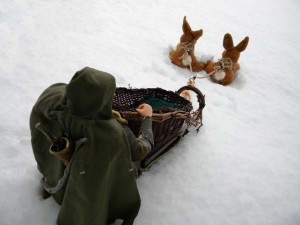 A sled is a logical way to move through a forest. Wheels would catch, bog and break, runners slide out over stuff. We have photos of my Dad’s Pennsylvania German family moving earth and rock with a mule and a stone sledge (how Dwarvish!), not a cart. I got a reply on one of my posts from someone else whose West Virginian ancestors had used similar sleds. North American did not have the wheel until European settlers arrived. Native tribes used sleds or travois (poles crossed over the dog’s back, they didn’t have horses either) to haul things. These are easy to build with a few branches; Radagast’s sled design is wonderfully quirky and branchy. The brush bow (at the bow or front of the sled) is pronounced like the thing Kili and Legolas shoot. The bow or front of the sled is pronounced like what Kili and Fili do when they arrive at Bilbo’s. The bow is designed to shed brush and obstacles; the sled slides or bounces off them. Or, with an overly enthusiastic team, like my friend’s, the sled crashes into trees and breaks your face… and you end up in the ER with a nurse going, “…did someone hit you?” (“Yeah, an Ent!”)
A sled is a logical way to move through a forest. Wheels would catch, bog and break, runners slide out over stuff. We have photos of my Dad’s Pennsylvania German family moving earth and rock with a mule and a stone sledge (how Dwarvish!), not a cart. I got a reply on one of my posts from someone else whose West Virginian ancestors had used similar sleds. North American did not have the wheel until European settlers arrived. Native tribes used sleds or travois (poles crossed over the dog’s back, they didn’t have horses either) to haul things. These are easy to build with a few branches; Radagast’s sled design is wonderfully quirky and branchy. The brush bow (at the bow or front of the sled) is pronounced like the thing Kili and Legolas shoot. The bow or front of the sled is pronounced like what Kili and Fili do when they arrive at Bilbo’s. The bow is designed to shed brush and obstacles; the sled slides or bounces off them. Or, with an overly enthusiastic team, like my friend’s, the sled crashes into trees and breaks your face… and you end up in the ER with a nurse going, “…did someone hit you?” (“Yeah, an Ent!”)
A sled moving over a bumpy landscape is rather like a small boat moving over bumpy waves. The kayak and the dogsled have common DNA: ** “Before contact with Russians in 1732, Inupiaq and Yup’ik peoples of the Bering Straits had already adapted their masterfully designed wood latticed and gut-skin covered kayaks into an over-the-snow craft, minus the skin but plus ski-like runners to glide over snow when pulled by dogs.”
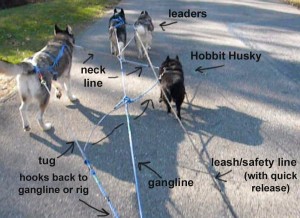 Radagast appears to be using a classic gangline to attach his bunnies to the sled. The gangline hitch (like a pinnate leaf; one long line with shorter “tugs” coming off of it) is designed for narrow twisty trails. The gangline goes down the center of the team, dogs (or bunnies) on either side, attached by the tugs. You can find Youtube video of mushers going through woods with large teams; the whole line of dogs snaking through the forest, around and over obstacles, the leaders will be out of sight around a bend. In this environment, a cart with stiff shafts of wood or a wagon with a wooden tongue does not work. In the open reaches of the arctic. Natives use a fan hitch (like a palmate leaf), each dog on its own line attached to the sled. Early Alaskan and Yukon explorers often used a single line of dogs in “horse collars” with traces; lines on each side of each dog.
Radagast appears to be using a classic gangline to attach his bunnies to the sled. The gangline hitch (like a pinnate leaf; one long line with shorter “tugs” coming off of it) is designed for narrow twisty trails. The gangline goes down the center of the team, dogs (or bunnies) on either side, attached by the tugs. You can find Youtube video of mushers going through woods with large teams; the whole line of dogs snaking through the forest, around and over obstacles, the leaders will be out of sight around a bend. In this environment, a cart with stiff shafts of wood or a wagon with a wooden tongue does not work. In the open reaches of the arctic. Natives use a fan hitch (like a palmate leaf), each dog on its own line attached to the sled. Early Alaskan and Yukon explorers often used a single line of dogs in “horse collars” with traces; lines on each side of each dog.
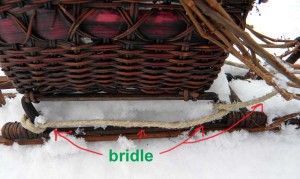 Epic fail: Radagast has his gangline attached to his brush bow. This is a sure way to have your super-powered Rhosgobel Rabbits pull your sled apart. The gangline is attached by way of a network of rope, called a bridle, to every upright “stanchion” on the sled, spreading out the stress. I have since seen some clearer pictures of the sled; it appears to have a support “keel” down the center, the brush bow attaches to this keel. Perhaps this is enough to strengthen it.
Epic fail: Radagast has his gangline attached to his brush bow. This is a sure way to have your super-powered Rhosgobel Rabbits pull your sled apart. The gangline is attached by way of a network of rope, called a bridle, to every upright “stanchion” on the sled, spreading out the stress. I have since seen some clearer pictures of the sled; it appears to have a support “keel” down the center, the brush bow attaches to this keel. Perhaps this is enough to strengthen it.
Let us now consider Wizard spit. A good team (say, the average Iditarod team of 16 dogs, weighing 40 to 70 pounds) can pull a sled over grass, turf, tussocks, debris, and that spikey stuff native to the part of New Zealand where they were filming some of those chase scenes. The Farewell Burn, on the Iditarod Trail, Alaska, was nearly impassable after a fire there in 1977. According to Zuma’s Paw Prints, on iditarod.com, “challenges (even today) include areas of glare ice, overflow, open water, wind and lack of snow.” (Yes, lack of snow, in March, in Alaska). The sleds traversing this are loaded for survival and pulled by sixteen dogs or less. A smaller team can pull a sled over frost. I have read accounts of mushers running over gravel and dirt roads with sleds (standing on one runner so you only wear out one runner at a time). I’ve run two medium sized dogs and a sled down a wooded park trail that had most of the snow melted off. I ran between the runners, and hopped on every time we hit a patch of snow or ice. For our bunny sled, let’s assume some sort of non-friction-creating Wizard spit on Radagast’s runners. If you watch a film called Fast Runner (done by a Native Canadian tribe, the Inuktitut), you’ll see, in the beginning of the film, the hero slicking his runners with ice… he is spitting water out of his mouth (warming it) onto a fur to rub on the runners.
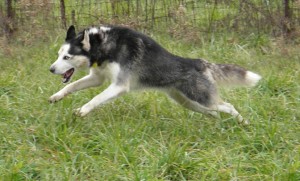
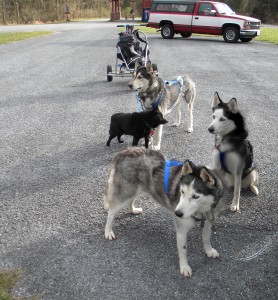 The sled dog is the strongest draft animal on earth. One thousand pounds of sleddogs is far more powerful than one thousand pounds of horse. Individual dogs can (in weight pulling contests, which they love) pull ridiculous weights: a forty pound champion pit bull pulled over two thousand pounds. And there is Maddie, the weight pulling poodle (youtube): five pound poodle, pulls six hundred pounds. Don’t know about rabbits, but those are Rhosgobel Rabbits. And they are not weight pulling. They are in the situation the Siberian Husky was bred for: to pull light loads, swiftly, over long distances. I know of at least one woman who ski-jored (where the dogs pull you on skis) with six Jack Russells (considerably smaller than Radagast’s rabbits). Aliy Zirkle (who has run the Iditarod many times) has a few lead dogs who are under thirty pounds. And my three Siberian Huskies share the gangline with one sixteen pound “Hobbit husky”, a Schipperke named Max. (rear to front: Legolas, Max, Denali and Chasseur).
The sled dog is the strongest draft animal on earth. One thousand pounds of sleddogs is far more powerful than one thousand pounds of horse. Individual dogs can (in weight pulling contests, which they love) pull ridiculous weights: a forty pound champion pit bull pulled over two thousand pounds. And there is Maddie, the weight pulling poodle (youtube): five pound poodle, pulls six hundred pounds. Don’t know about rabbits, but those are Rhosgobel Rabbits. And they are not weight pulling. They are in the situation the Siberian Husky was bred for: to pull light loads, swiftly, over long distances. I know of at least one woman who ski-jored (where the dogs pull you on skis) with six Jack Russells (considerably smaller than Radagast’s rabbits). Aliy Zirkle (who has run the Iditarod many times) has a few lead dogs who are under thirty pounds. And my three Siberian Huskies share the gangline with one sixteen pound “Hobbit husky”, a Schipperke named Max. (rear to front: Legolas, Max, Denali and Chasseur).
Faster than wargs? Dogs are faster than horses over the long haul, capable of maintaining average speeds of eight to twelve miles an hour for hundreds of miles (including rest stops), and can exceed twenty miles an hour or more on shorter sprints. A good Iditarod team completes the 1100 mile journey in less than nine days. A jackrabbit has giant ears and very long legs, is a powerful jumper and fast runner, alternating leaps with running steps, running fast and close to the ground, at speeds up to 45 mph. A cottontail rabbit has large ears and short legs and moves with a scurrying or scampering gait, they dig their own burrows and make a nest in a depression in the ground. Unlike the jackrabbit, they seek protection in hiding rather than in swift flight, though they can hit 35 mph. African wild dogs, coyotes, foxes and wolves can hit speeds of between 35 and 45 miles per hour. Greyhounds (bred specifically for hunting rabbits) are often called the 45 mph couch potato (for their laid-back temperament); average speeds are closer to 40mph, but 45 has been done. Wargs do not look a bit like greyhounds. More like… hyenas? Or Andrewsarchus. (totally sounds like: Andy Serkis). Andy was a six foot tall (at the shoulder) wolfish looking predator (actually, very much like a warg) of the Eocene (55 – 37 million years ago). Andy was part of the Mesonychid family, and had hooves (three, small, where the claws would be on a canine predator). Andy did not look a bit like a greyhound and was not, apparently, designed for speed (they may have been scavengers), though he would have certainly been big enough to ride.
Rhosgobel Rabbits could easily outrun wargs. And probably modern sprint racing dogs like German Shorthairs. Chasing Radagast’s team might create some new speed records on the ski-joring circuit.
Dogs run long distances as a hunting pack, in the direction you point them (or the trail leads). Rabbits run in zigs and zags to avoid predators. Cats hunt by stealth, and run in short bursts. Hooking up a dozen bunnies and getting them to go in the same direction has to be challenging for Radagast, as they naturally want to run in all directions at once. His bunnies appear to be cottontail types, though a faster hare or jackrabbit might have made more sense. I’ll need to have the DVD to pause and study the species! Oh, wait, those are Rhosgobel Rabbits.
Sled cats would not work well at all. Rabbits? Not sure. While people have done bunny agility and dancing with your bunny (“freestyle”) I haven’t heard of bunny endurance races.
I did try Max’s harness on my one cat, Sindarin and discovered that cats can swear, really well